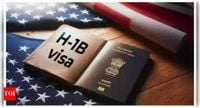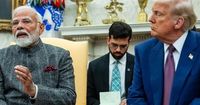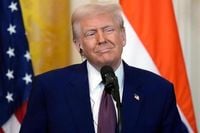On September 19, 2025, President Donald Trump signed a sweeping presidential proclamation that has sent shockwaves through the U.S. tech sector, academia, and immigrant communities worldwide. Effective just two days later, at 12:01 a.m. Eastern on September 21, the new policy imposes a $100,000 fee on all new H-1B visa applications filed from outside the United States. The abrupt rollout of this measure has left employers, workers, and legal experts scrambling for clarity, with confusion and fear rippling from Silicon Valley to Bengaluru.
The H-1B visa, created by the 1990 Immigration Act, has long been a lifeline for American companies seeking to hire foreign workers with specialized skills, especially in technology and engineering. According to Pew Research Center, at least 60% of H-1B visas approved since 2012 have gone to computer-related jobs, and nearly three-quarters of successful applicants in 2023 hailed from India. The program is capped at 65,000 new visas per year, with an additional 20,000 available for candidates holding advanced degrees. As of 2025, there are approximately 700,000 H-1B visa holders in the U.S., alongside half a million dependents.
Yet, the Trump administration’s new fee marks one of the most dramatic changes to the program in decades. As reported by Associated Press, the White House initially struggled to reassure existing visa holders that the policy would not strand them abroad or affect their ability to travel. After a flurry of anxious inquiries, officials clarified that the $100,000 fee applies solely to new petitions filed after September 21, 2025, and does not impact renewals or current visa holders’ travel rights.
Commerce Secretary Howard Lutnick, who stood beside Trump during the signing, explained the administration’s rationale: “If you’re going to train someone, you should train a recent graduate from one of our nation’s esteemed universities. Let’s train Americans and refrain from bringing in individuals to take our jobs.” The White House echoed this sentiment in a fact sheet, arguing that “American workers are being replaced with lower-paid foreign labor, creating an economic and national security threat to the nation.”
The administration’s move is rooted in longstanding criticisms of the H-1B program. Critics, including some labor advocates and policymakers, allege that companies exploit the visa to undercut American wages and outsource jobs. The White House cited examples of major tech firms receiving thousands of H-1B approvals while simultaneously laying off U.S. employees. One company reportedly secured 5,189 H-1B workers in fiscal 2025 while laying off 16,000 U.S. staff; another received 1,698 approvals while cutting 2,400 jobs in Oregon.
“To take advantage of artificially low labor costs incentivized by the program, companies close their IT divisions, fire their American staff, and outsource IT jobs to lower-paid foreign workers,” the White House stated in its proclamation. The fact sheet further noted that the share of IT workers with H-1B visas has jumped from 32% in 2003 to over 65% in recent years. Unemployment among recent computer science and engineering graduates now exceeds 6%, more than double the rates for biology or art history majors. The administration contends that this trend discourages young Americans from pursuing STEM fields, potentially threatening national security.
President Trump’s new policy also directs the Department of Labor to revise prevailing wage levels for H-1B positions, prioritizing high-skilled, high-paid workers. The aim, officials say, is to ensure that the program attracts only the “best and brightest” and does not serve as a backdoor for cheaper labor. Trump himself predicted that the changes would likely result in fewer H-1B visas being issued, as sponsorship becomes “just not economically viable anymore.”
But the consequences of the fee are already being felt far beyond the intended targets. According to Capital Economics, while major tech firms like Amazon (with 12,391 H-1B workers), Microsoft (5,189), and Meta (5,123) may be able to absorb the multimillion-dollar costs, the upfront fee “will clearly be too high for many companies to stomach.” In 2024, sectors such as healthcare, retail, and food services accounted for a quarter of H-1B visas, and many firms in these areas are expected to struggle with the new financial burden.
Startups and small businesses—often the birthplace of innovation—are especially vulnerable. Greg Morrisett, dean and vice provost at Cornell Tech, warned, “There’s no way they can pay them. The next Amazon, the next Google will give up here and go somewhere else and then we won’t have that advantage in the next generation of tech leadership.” He added that some startups may relocate operations to Europe or Asia, echoing past trends when countries like Ireland offered favorable business climates.
The policy has also sparked widespread confusion and anxiety among foreign workers and students. Leon Rodriguez, former director of U.S. Citizenship and Immigration Services, told the AP, “There’s still some folks out there recommending to their H-1B employees that they not travel right now until it’s a little clearer.” Many are concerned about the lack of a clear payment process and whether the fee will apply to universities and nonprofit research organizations, which have traditionally been exempt from annual caps.
Legal experts and immigration attorneys describe the situation as “flying in somewhat foggy conditions.” Bo Cooper, a partner at Fragomen, Del Rey, Bernsen & Loewy, pointed out that “key questions remain, such as whether the new fee will apply to universities and nonprofit research organizations, employers that Congress has exempted from the annual limit on H-1B visas.” The lack of clear guidance has prompted some to anticipate a wave of emergency litigation, with affected workers and employers seeking nationwide injunctions to halt the policy’s implementation. Lawsuits are expected to focus on the abrupt timeline and potential due process violations.
For many aspiring immigrants, the new fee feels like a door slamming shut. Alan Wu, a data scientist in Indianapolis, shared his frustration: “Can you release some policy which impacts tons of people just like that?” After failing to win the H-1B lottery for two consecutive years, he’s now rethinking his plans to settle in the U.S. “I am definitely concerned about my job now that the cost and risk of hiring a foreigner is so high.”
Navneet Singh, who runs an immigration consultancy in India, predicted that the policy would “significantly impact future migration to the U.S., particularly from India.” He argued that “Trump is trying to suffocate new immigrants who are skilled, so that they won’t take the jobs away from the average American. But by doing so, they will be making (U.S.) production expensive.” Singh also suggested that other countries—France, the Netherlands, Germany, and Canada—stand to benefit as skilled workers look elsewhere.
Despite the White House’s insistence that the fee is a necessary step to protect American workers and national security, the move has deepened divisions over immigration policy. Supporters argue that the measure fulfills a campaign promise to put American workers first, while critics warn it risks stifling innovation, harming small businesses, and driving global talent away from the U.S. As the legal and political battles unfold, the future of high-skilled immigration—and America’s role as a magnet for global talent—hangs in the balance.
For now, the only certainty is uncertainty. Workers, employers, and families are left waiting for answers, their futures suspended as the nation debates what it means to put “America First” in a world that’s more interconnected than ever.


